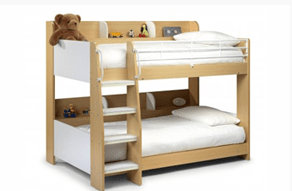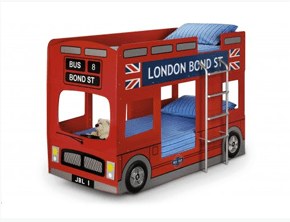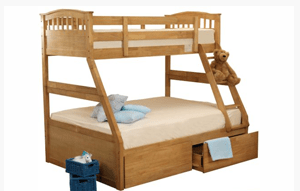Buying Bunk Beds – 6 Things To Consider
If you have children who share a room, getting bunk beds is a great way to save space in your home and it can also be a much cheaper option, compared to investing in two separate beds.
But with news stories often highlighting the dangers and injuries which can occur from bunk beds, many parents are wary of purchasing them.
There are also certain style issues to consider, as bunk beds come in a variety of different types, different materials and have different features.
So, if you’re going back and forth, wondering whether bunk beds are a good idea for your children, we have compiled a list of things to consider before you buy.
1. What kind of bunk bed do you need?
Bunk beds fall under many different categories, but most commonly they are twin-over-twin, to sleep no more than two.
If, however, you have a lot of sleepovers or an older child who needs more space, you might want to consider a triple-sleeper bunk bed with a twin over a double.
If the bedroom is small, you might want a bunk bed with storage at the bottom and if you have a child who is older and may one day get their own room, you might want to choose one where the bottom bunk can be converted into a sofa or taken out and replaced with a desk and study area.
2. Do you have the space?
Bunk beds do typically save space, but the frame can be larger than a normal twin bed, so be sure to measure the bedroom to determine whether a bunk bed will fit comfortably, with plenty of room for the children to get in and out.
3. Building Your Bunk Beds
Whilst there are bunk bed injuries every year in the UK and Ireland, bunk beds are safe when purchased from a trusted, quality retailer and installed properly. Bunk beds from TJ Warehouse come with installation instructions and we always recommend that they are built and checked by two people.
4. How Old Are Your Children?
The Child Accident Prevention Trust recommends that children under six should not sleep in a top bunk. However, this will also depend on the child. If your child is frightened of heights, bunk beds are not a good idea. Likewise, if they are prone to get up during the night, or sleep walk, they could potentially injure themselves.
When shopping for bunk beds, it’s always a great idea to bring your children with you. Let them test the beds and make sure they feel confident and able to climb up and down the ladder. You might find that a child who was once extremely excited by the notion of bunk beds, soon goes off the idea when they realise how high up they are.
5. Additional safety concerns
As well as falling from bunk beds, injuries can also arise when children get trapped or even wrapped in cords. For that reason, you should check your bunk beds often to ensure that they remain sturdy and haven’t incurred any structural damage over time or from children playing. Also, keep the beds far away from any cords or wires.
6. Future plans
Bunk beds may be cost effective now, but you will also want to consider the longevity of your bunkbeds to ensure that they will be value for money over time.
As your children get older, they may decide they no longer want to sleep in bunk beds (the novelty can ware off pretty quickly for children aged 10+). Or perhaps, they’ll simply get too big to fit in their bunk beds. So, if you’re going to purchase, it’s worth investing in a bunk bed that is likely to stand the test of time. Make sure your bunk beds are long enough for kids to grow into and be sure that there will be enough space between the bunks as they get taller to prevent them from hitting their heads.



